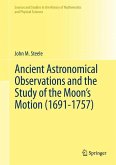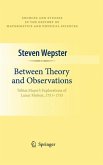Dieser Download kann aus rechtlichen Gründen nur mit Rechnungsadresse in A, B, BG, CY, CZ, D, DK, EW, E, FIN, F, GR, HR, H, IRL, I, LT, L, LR, M, NL, PL, P, R, S, SLO, SK ausgeliefert werden.
"This is the second book on historical aspects of lunar theory to have been published by Springer within a twelve-month period. ... the text is largely accessible without specialist knowledge of its central themes. ... this text is mainly one for specialists. ... the history of lunar theory introduces many fascinating ideas, and it refers very many creative mathematicians and astronomers." (Peter Ruane, The Mathematical Association of America, August, 2010)
"This excellent book is a cornerstone in the history of astronomy. It deals with the Hill-Brown theory of the Moon's motion between 1877 and 1984. ... This lively written book contains many biographical notes and well-founded historical comments, and thus can be recommended to amateurs in astronomy and science history, and to instructors and scholars interested in the rapid development of astronomy and physics." (Johannes Viktor Feitzinger, Zentralblatt MATH, Vol. 1202, 2011)









